Content Warning: This essay contains graphic images of a highly sensitive nature.
Photography is central to telling the story of Emmett’s brief life, his tragic death, and his mother’s resistance. The black-and-white photos that remain from that history/herstory enshrine mother and son in an era when postcards of lynched Black people were circulated around the country as souvenirs and long before viral images of police brutality dominated our social media feeds. Mamie used photography to document her son’s life, from his infancy to his teenage years, and to preserve the closeness of their relationship. Through her orchestration of the visual record after Emmett’s death, she embodied hooks’s understanding of the “power of the photograph, of the image, that can give back and take away, that it can bind.”1 Her overall curation of these images demonstrates the ways in which Black people have had to create DIY galleries and museums of their own to reflect the truths of their existence and to harness the power of their loss and grief. My own great-grandmother was a curator of knickknacks and family portraits in china closets that we handled with tenderness and care, the equivalent of white gloves. Every Saturday morning, we polished the wood and the glass encasing them.
At the center of Mamie’s resistance to white supremacy is the now legendary story of how she insisted on Emmett’s casket being open at his funeral on September 6, 1955. As she told the funeral director, “Let the people see what I’ve seen.”2 She wanted the world beyond the thousands who would attend Emmett’s funeral and viewing to know how white men in Mississippi had brutally assaulted and mutilated her fourteen-year-old son. She chose a Black photographer, David Jackson, to take pictures of Emmett's body and allowed those images to be printed on the cover of Jet magazine on September 15, 1955, and in several other African American publications. Jackson’s photo of Till in his casket has become one of the many that contribute to his public memory and are emblematic of the horrors of white supremacy.
In a cropped photo taken at the mortuary, Emmett’s swollen and disfigured face fills the foreground, appearing like a mask of stone or a head made of marble, and with, as writer John Edgar Wideman described, “all the boy, all the human being battered out of it.”3 Behind him, Mamie stands next to her future husband, Gene Mobley. There is an upward twist of her lips, which we can surmise are painted a rich shade of red. Her expression reads disgust, but her eyes look lovingly upon her son. She wears a dark dress printed with animal figures that resemble hieroglyphics and a slender watch with a square face.
Gene looks directly into the camera, his eyes wide with something between sadness and dread. He holds his glasses between the fingers of his left hand, and both of his hands grip Mamie in place by her right wrist and left arm, as if she might float away. Both look like they are holding something in their mouths—a scream, a sob, words they cannot express at this moment and would be pointless in the presence of an unfamiliar Emmett.
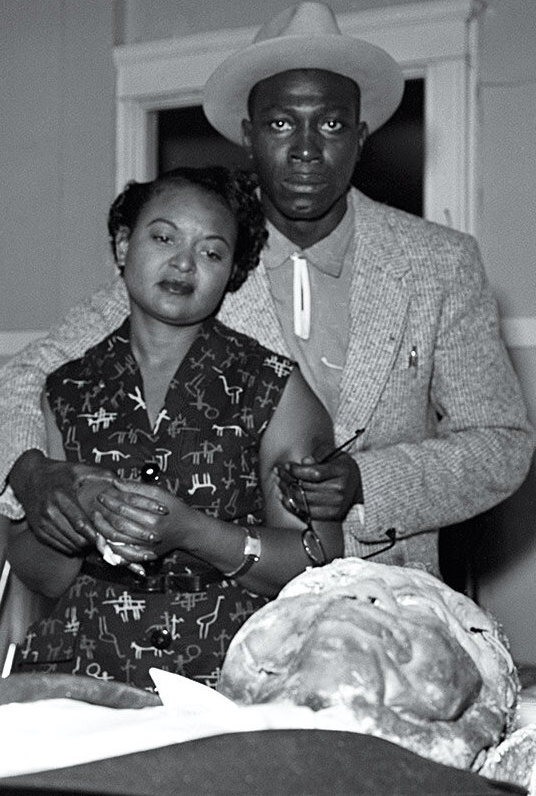
Mamie Till looks over the body of her son Emmett Till at the morgue before his funeral. With her is her fiancé, Gene Mobley. First published in Jet magazine, September 15, 1955. Photo by David Jackson. This photo is in the public domain.
The photo shows varying degrees and kinds of protection and care—for and by Mamie, for Emmett, by Gene—as well as Mamie’s reverence for Emmett’s spirit, no matter the condition of the final form of his body. From the impeccable yet simple way that Mamie and Gene are dressed, to the intimate position of their bodies, the image offers Black love and dignity as a shield against white cruelty and silence.
My mother, who will be seventy this year, was the first person to tell me about Emmett Till. Born November 23, 1955, she shares a birthday with Emmett’s mother, Mamie Till-Mobley (born thirty-four years earlier), and came into the world some three months after Emmett’s death. But my mother grew up knowing the story of Emmett’s brutal murder because it was told to her as a cautionary tale by Black folks who had heard the news and seen the photos of Emmett lying in his casket, Black folks who had come North to avoid such horrors but knew that even with that distance from “home,” they were not immune to or safe from what happened to him. And neither were the children, in their innocence free from such cruelty, which the images brought them even closer to. This cruel wisdom was also passed on to me, a blueprint that lives in my bones, a fear, a nightmare, a fever dream. I remember connecting those dots when the Ku Klux Klan marched down Main Street in North Wales, Pennsylvania, two blocks from my house in the late 1980s, and I had visions (or were they memories deep in my DNA?) of a cross burning on our front yard in the Philadelphia suburbs.
The foundational essay “In Our Glory: Photography and Black Life” by bell hooks guides me as I think about the lives of Emmett and Mamie. Hooks discusses the importance of photography by and of Black people, particularly Black families:
Cameras gave to black folks, irrespective of class, a means by which we could participate fully in the production of images. . . . Before racial integration there was a constant struggle on the part of black folks to create a counterhegemonic world of images that would stand as visual resistance, challenging racist images.4
***
In February 2025, my husband Mark, my son Theo, and I traveled from Philadelphia to Chicago to tour sites in the city related to Emmett and Mamie Till. That day, as we encountered more images from their lives, we created our own—an emergent photographic history built on their legacies. In the end, we felt a captivating and stirring awe that grew from the horror embedded in their visual narrative of love and loss.
Our tour guides were retired social studies teacher and girls’ basketball coach Mike Small and his wife, Tina.5 They were both raised in Chicago and have been married for fifty years. For twenty-five years, they have been giving presentations about Emmett’s and Mamie’s story for all ages across the United States and abroad, including Australia, Canada, and Ireland. It all began in March 2000, when they visited Mississippi in search of blues and jazz in Clarksdale, and Mike saw a quote about Emmett in a blues museum. He said to Tina, “Why don't we try to find out where Money, Mississippi, is, and we'll look for the store [where the infamous interaction between Emmett and Carolyn Bryant took place].” But when they got to the location where Money was indicated on the map, there was no sign to mark what had happened there. It was only from his research of Emmett’s story that Mike knew that the dilapidated structure on the corner held a crucial place in American history: “I looked around, and I knew from pictures I had seen before that that was a store over there . . . And we went over there and I got my camera out.” Mike was so inspired by the trip that he got back to Chicago and told his high school students about it: “The students were just fascinated. They never heard anything about [Emmett Till] before. And then . . . this girl changed my life. Girl sitting in the last row, third seat. She said to me, ‘Mr. Small, is Mamie Till still alive?’ And I didn't know the answer to that . . . .”
In search of an answer, Mike sought out Mamie through a contact at the Chicago History Museum and eventually he and Tina found themselves invited to her home on a Sunday afternoon. They had brought along a scrumptious Italian dinner, prepared by Tina, which included antipasto salad, meat lasagna, eggplant parmesan, garlic bread, gelato, cannoli, biscotti, strawberries, and wine. Mamie came to the door using a walker and gave them both hugs. They spent three hours with her that first day, and in the years that followed they grew close through regular visits and phone calls. One afternoon, Mike invited her to his school to speak with his students. Mike recalls, “It was the best assembly we ever had. And [usually] at the end of the assembly, those assemblies at the end of the day, as soon as the bell rings, everybody’s out of there. [But for this one], the kids [did] not move. They lined up in a long line around the entire auditorium to have a picture taken with her one at a time.” Meeting Mamie—one of the most “extraordinary human beings” he has had the opportunity to meet, Mike says—galvanized him to begin working with the Emmett Till & Mamie Till-Mobley Institute in Summit, Illinois, and the Emmett Till Interpretive Center in Sumner, Mississippi. Before she passed away in 2003, he and Tina promised her to keep the story of what happened to her son alive.
Mike and Tina showed us a photo of Mamie they had taken during one of their visits to her home. She is seated in a wooden chair in her kitchen, a dish rack and a large jug visible on the counter behind her. Wearing gold-rimmed glasses, she peers at a document through a magnifying glass. The picture reminds me of my great aunt Gladys, aka Sookie, who never had children of her own, but was a lifelong, live-in caretaker for so many elders. Sookie collected her ceramic clown figurines and read her crime fiction and romance novels in a peace made from Jesus and moonshine. She had the same wizened, black chestnut skin and kept her salt and pepper hair short because she “couldn’t be bothered about no hair” at her age. She, too, knew deep trauma, loss, and longing. This is a different Mamie than the one we see in the black-and-white photos, all dressed up, every hair in place, wearing the girdles and bras that prop up womanhood. This older Mamie, wearing a comfortable white T-shirt, could be my aunt just come home from work and been took off that bra because she was finally in for the night. I know women like Mamie who give and give and care so much about the world even when it has taken so much from them. They live every day the values this country should run on but doesn’t. They may appear to be ordinary women on the margins of society, but they are larger than this life.

Mamie Till-Mobley, c. 2003, Chicago, IL. Photo courtesy of Mike and Tina Small.
Mike and Tina lovingly tended to us as if we were family, a delegation of diplomats, and students on a field trip. To start our tour, they picked us up in front of our hotel on a Tuesday morning around 11:00 am, and the three of us piled into the back of their Prius with our big coats on; it was below twelve degrees that day. Our first stop was the Chicago History Museum on North Clark Street. We were there to see Injustice: The Trial for the Murder of Emmett Till, an exhibition of photographs and drawings related to Emmett’s life, murder, funeral, and the trial in Tallahatchie, Mississippi. When we got upstairs, Mike slipped effortlessly into teacher mode, becoming an unofficial docent, expertly taking us through the context behind nearly all the photos, drawing us in with his remarkable storytelling abilities. Oftentimes he would get so animated relating the background details of a photo that he would raise his voice to the point that Tina felt the need to lovingly shush him. I was struck by the triggering power of these pictures—they sparked both Mike’s energetic accounts and our sobering rage. It was overwhelming to see some of them hung on the wall and enlarged for all to see as opposed to being tucked in a scrapbook or nestled in an archival box. Unhidden and on display, they created a hush over the exhibition; taking it all in, we stood in front of each photo as if offering a confession of shock and disbelief.
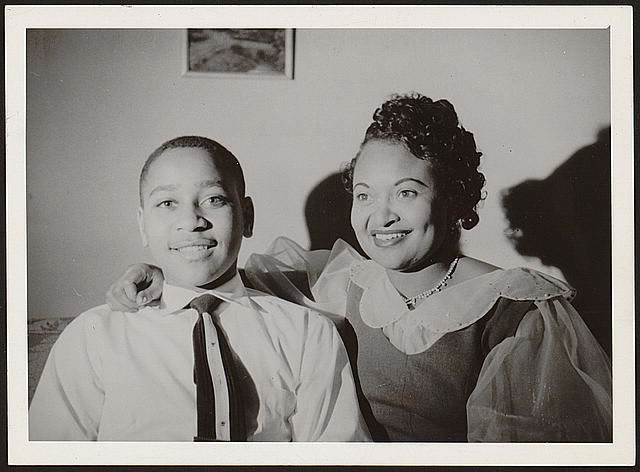
Emmett Till and Mamie Till-Mobley. Photo courtesy of Florida State University Libraries.
The first picture in the exhibition was a particularly beautiful one of Emmett and his cousin Wheeler Parker standing astride their bikes, with a family friend perched on Wheeler’s seat, in Summit, Illinois, circa 1950.6 The smiling Emmett in the photo has to be about nine years old. Wheeler and the friend look like they are mean-mugging for the camera or suspicious of the picture-taker. In fact, Wheeler kind of looks the part of the protective big cousin. (I know that look well and have worn it more than a few times.) Emmett, on the other hand, could be posing for an ad, exhibiting a comfort and ease in his body, effortlessly balancing the bike with both hands. Handsome with his fresh cut, his cheeks the shape of shiny little crabapples, reminiscent of photos of him as an infant. The boys pose on a tree-lined street. One wonders what adventures they had on their bikes that day or were headed for. Did they ride around the neighborhood or were they limited to the street outside the family home so someone could keep an eye on them?
More well-known photos of Emmett and Mamie followed in the exhibition, including one taken at Christmastime in 1954, the year before Emmett went down to Mississippi. Mother and son are dressed to impress (did Mamie ever miss in this department?). He’s wearing a white shirt with a dark tie with a light stripe down the middle, and she’s wearing tight curls swept to one side of her head and a shirt with white ruffles and voluminous sleeves. outfit is something a princess or fairy godmother might wear, like Lena Horne in the final scene of The Wiz—a beautiful woman who is also a protector. Mamie’s jewelry is understated and delicate. Emmett looks directly into the camera, while his mother looks into the light coming from his right side. (This positioning reminds me that I’ve seen few photos of Mamie looking directly into the camera.) A small part of Emmett’s head is in shadow, and the shadow to the left of Mamie almost looks like the head of an animal—a dog or a bear. There is a picture on the wall above them. Her arm rests on his shoulder in a loose fist. They both look happy and proud.
We too have photos of our once-happy family, in the early 1980s, posed together on the couch, stepdad in a white T-shirt, Mom with the biggest smile and a blowout, in a striped shirt with pants the color of hot sauce. My sisters and I are wearing pink linen and white lace, our hair in cornrows and barrettes, holding our stuffed animal siblings—a bear, a dog, and an elephant. There is a framed landscape painting on the wall behind us: fields of grain with a small grove of trees huddled together like a family. After my parents’ divorce, there are no photos of Mom and her three girls. But in the photo of Emmett and Mamie, I see a single mom and her son, insisting on being a whole family even without a father or husband figure in the picture
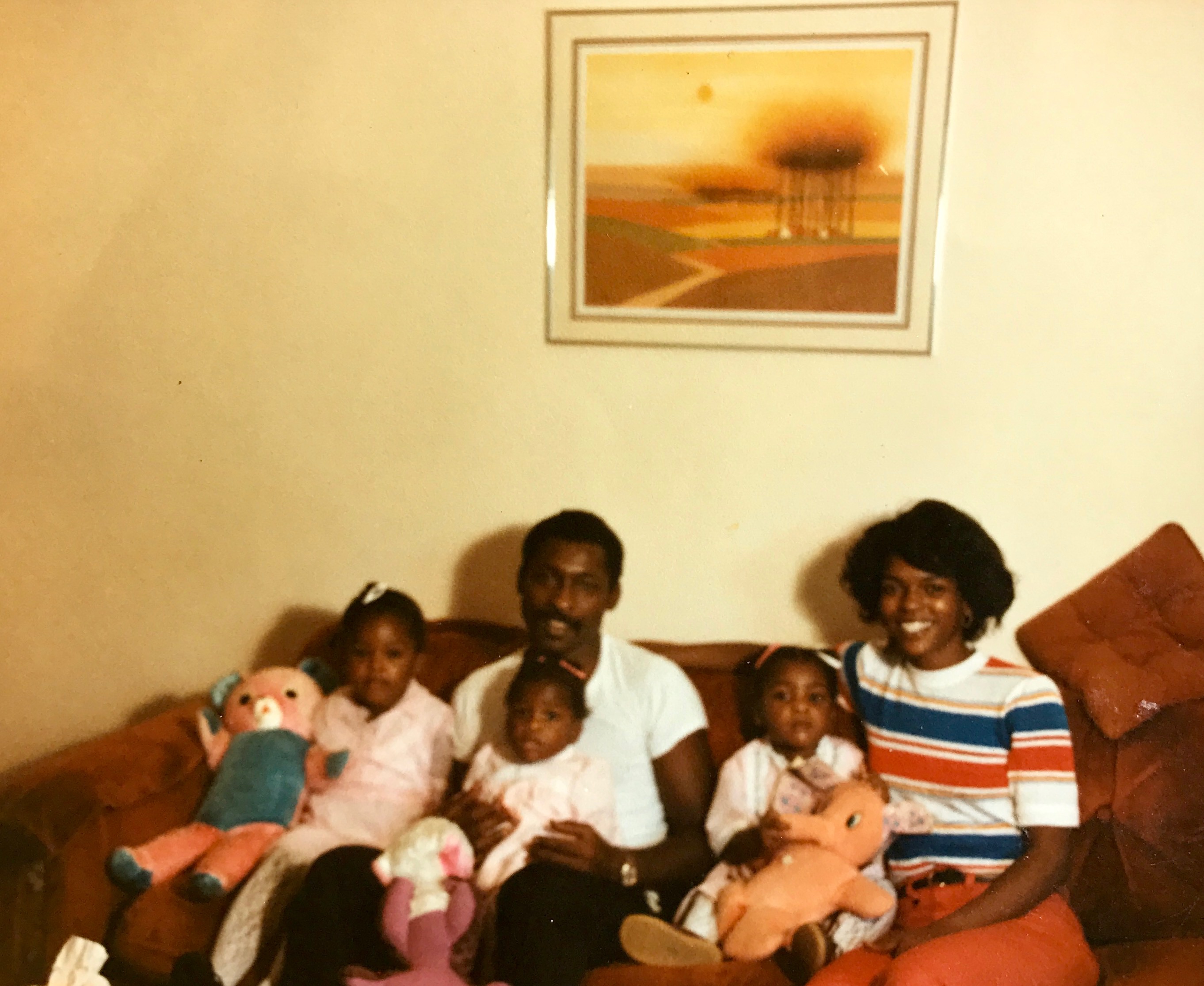
Wisher Family, c. 1982, North Wales, PA. Photo courtesy of Yolanda Wisher.
The snapshot of Emmett on the bike and the Christmas photo stood in sharp contrast to the pictures of Mamie receiving the coffin with Emmett’s body, the open casket revealing the young boy’s mutilated face, and the funeral at Roberts Temple—images that, paired with Mike Small’s graphic descriptions, weighed heavily on all of us. I watched my son’s shoulders sink and his energy wane under the heaviness of this horrific tale and its imagery. I had to hold him together in the museum. I had to tell him it was okay to look away.
Many of the images from the exhibition remain with my spirit, particularly one of Emmett’s great-uncle Moses “Mose” Wright, a minister and sharecropper. Emmett was taken from Wright’s home by his murderers in the early morning of August 28, 1955. Forced to choose between protecting his own family and his great-nephew, Wright had been torturously unable to prevent the kidnapping. But this photo captures a moment of redemption and renewed audacity less than a month later. In the Tallahatchie courthouse during the trial, Wright points at the out-of-view defendants, John W. Milam and Roy Bryant. Photographs were not allowed to be taken during testimony in the courtroom, but Ernest C. Withers, a Black photographer who sat at a segregated table with Mamie, hid a camera inside his coat and immortalized what is perhaps the first time a Black person “outright accused a white person of a crime in that Sumner, Mississippi courtroom”7 or the South in general and lived.8
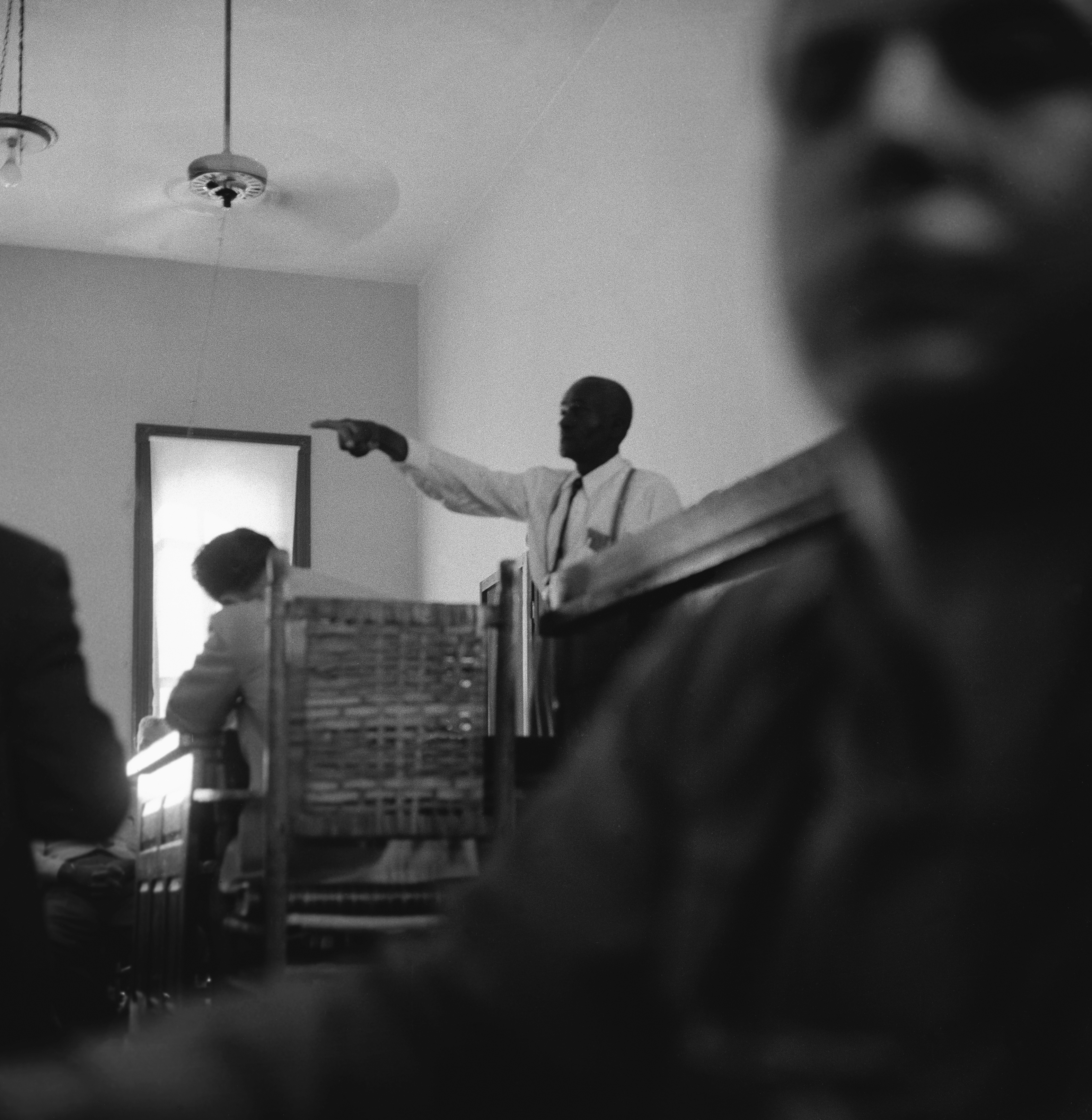
Wright’s finger is a lightning rod, pointing like a black manicule in a direction we cannot see for ourselves. His facial features are barely visible. Another man’s blurred face and upper body are all up in the camera’s space, but Wright holds court under the whirring fans, a pillar, a streetlamp, a tree. If his hands were shaking in this moment, it is imperceptible here. That finger is sure of itself, attached to a man standing straight and tall on the witness stand. You can feel Wright’s courage as well as the courage of the photographer to document this scene even though it was against the rules. What was supposed to remain secret—white guilt—is exposed, yet we don’t see the accused because they are outside this shot, “outside the groove of history”9 in a more sinister way than Ralph Ellison’s invisible man; we are left to imagine them and their response. Moved from fear to bravery as a result of Emmett’s life being taken away, Wright points into the face of evil and dares it to prove him wrong.
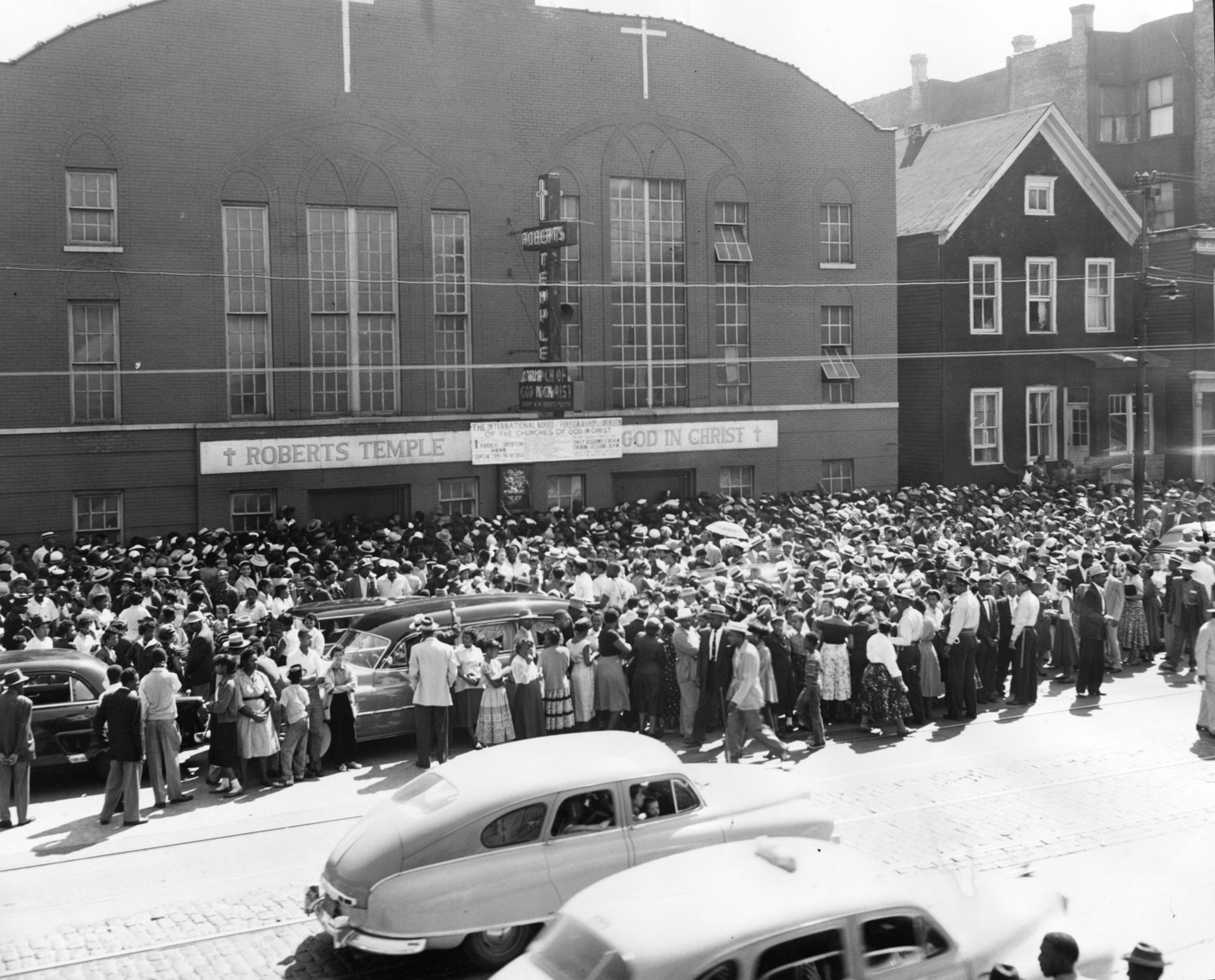
Following our time at the museum, Mike and Tina guided us to several other sites of importance to Emmett and Mamie. We visited Roberts Temple Church of God in Christ (4021 South State Street) in a historically Black neighborhood, which poet Gwendolyn Brooks enshrined in her 1945 collection, A Street in Bronzeville. This was Mamie’s and her mother’s home congregation, its pews and balcony packed with mourners for the viewing of Emmett’s body on September 6, 1955. The church is part of the Emmett Till and Mamie Till-Mobley National Monument that includes sites in Illinois and Mississippi. Photos from the day of the funeral show the sidewalk outside filled with throngs of mourners. Folks dressed in hats, slacks with suspenders, and prim skirts, their hands on their hips or folded across their chests, wait patiently to see what Mamie beckoned them to see. The church stands in the background like a shadowy ark or a fortress holding a secret. The full-grown trees that now line both sides of the street didn’t exist then.
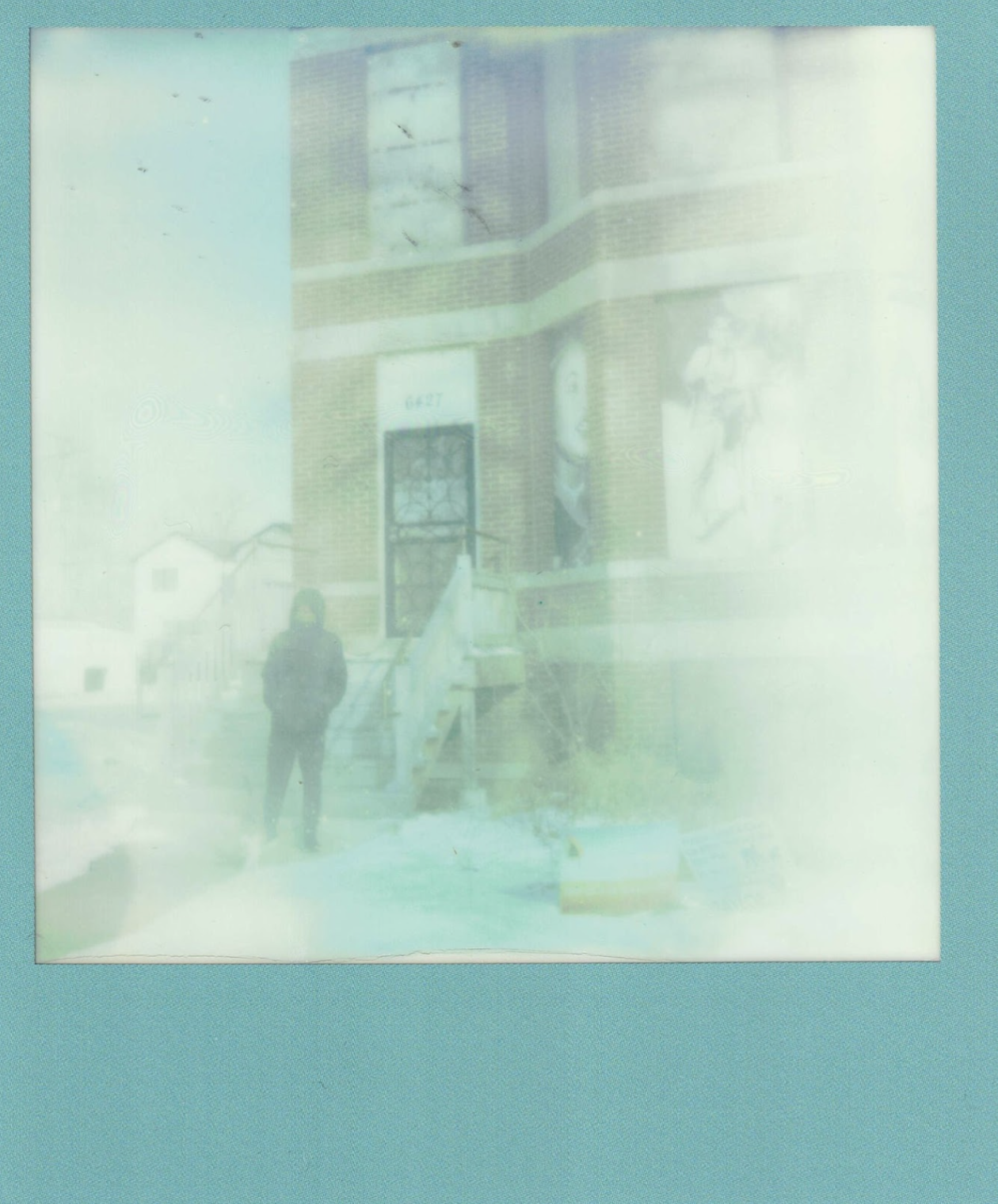
Theo Palacio, 2025, Chicago, IL. Polaroid by Yolanda Wisher. Courtesy of the author.
We also visited the Emmett and Mamie Till-Mobley House (6427 South Saint Lawrence Avenue) in the Woodlawn neighborhood on Chicago’s South Side. The brick home, where Emmett lived in the last years of his life and Mamie remained until the early 1960s, is being renovated into a museum. Mother and son stayed on the second floor in a three-bedroom apartment. Mamie once said, “Our house was the meetinghouse, the gathering place, the center of the community. It was the place where Mama had helped to found the Argo Temple Church of God in Christ, and where she recruited new church members with practically each new Mississippi migrant.”10 Some seventy years later, the windows are covered by giant photos of Mamie and Emmett, seemingly frozen in time, perpetually looking out to the street, its neighbors, and passersby. In the bitter cold, a gray and white outdoor cat came across the street and became the main character in all the pictures we took there, rubbing against our legs and striking a pose. I took a few Polaroids of Theo on the steps Emmett must have run up and down after school and in the summers, but the images ended up washed out and ghostly, as if Theo and the house were caught in a snowstorm. Like the church, the building had an aura of unfinished business that epitomized Emmett’s life and Mamie’s fight for justice.
We drove a longer distance to Burr Oak Cemetery (4400 West 127th Street, Alsip, Illinois) where both Emmett and Mamie are buried. Tina brought two bouquets of pink tulips for us to lay on their graves. Mike told us about Mamie’s burial in January 2003. He was a pallbearer that day and remembers, “The hearse was not here yet. And when we pulled up . . . what they had over here was a white carriage with four white horses. And they had a Dixieland band behind the carriage. So when they pulled up, we had Mamie's casket, put her in the carriage, and they started playing ‘When the Saints Go Marching In.’”
To Mike’s knowledge, no one visually documented those solemn yet spirited proceedings, so the memories of the attendees (family, friends, and civil rights leaders) and Mamie’s gravesite may be the only remnants of the occasion. Somehow Emmett and Mamie’s story both courts images and resists them, both “gives back” and “takes away,”11 Like our modern age of social media, where everything, even the savagery of racially and sexually motivated violence is documented and shared for all to see, their story has been documented more than those of thousands of others who were lynched and killed in the South during that time. But it is also shrouded in the mystery of everything that went on behind the scenes to foil and disrupt justice as well as to preserve human dignity and privacy.
It continues to be a tale of light and shadows, of truth and subterfuge, its photographic and architectural artifacts dappled in historical twilight. Standing in front of Mamie’s resting place, as if she were now a saint who could offer shielding, I asked her to give me the strength to protect my boy from a past that won’t die.
Our second-to-last stop was Argo Community High School (7329 West 63rd Street, Summit, Illinois), Mamie’s alma mater, where she was an honor student. On the school grounds is a bronze sculpture of Mamie, by artist Sonja Henderson: dressed to the nines, she stands at a podium, her hand extended as if making a point while delivering her speech. A portrait of Emmett, cropped from the bicycle photo, is set like a jewel in the front of the podium. Theo and I took several snapshots of ourselves holding her figure’s open hand. After Emmett died and his murderers were set free, Mamie could have surrendered to misery and despair, but instead she went back to school to become a teacher and dedicated her life to children in Chicago. As a former high school teacher myself, I felt a deep respect and admiration for her.
Our family took a group photo with Mike and Tina in front of the statue, the soft, crunching snow underfoot reminding us of the cornstarch that the town of Argo is famous for. You can’t tell from the picture how much the cold of Chicago and Emmett’s story were in our bones at this point in the trip, nearly three hours after we started, because by this time, Mike and Tina were like grandparents who had warmed up to us and warmed us with invitations back to the city for Italian dinners and jazz festivals. We tower over them the way we towered over the statue of petite Mamie. She seemed to bring us all together, in the same way she handed her sad and strong story over to so many, including the Smalls, and now to the three of us—to carry, to guard, and to keep warm like votaries of an ancient and awful faith.
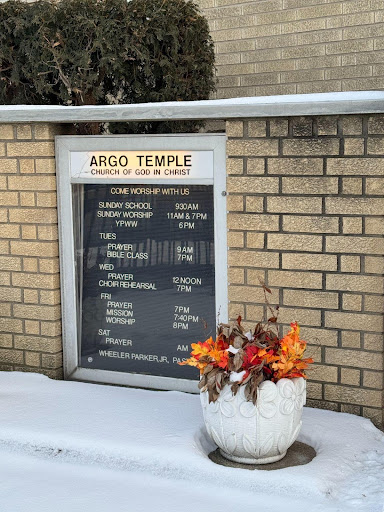
Following our visit to the high school, Mike and Tina drove us to the Argo Temple Church of God in Christ, founded by Emmett’s grandmother, Alma Spearmon. Reverend Wheeler Parker Jr. is the pastor there now; he is the cousin who traveled with Emmett from Chicago to Mississippi—and the last living witness to his kidnapping. Mike wanted us to meet him, but Parker was out of town that week.
At first we couldn’t find the church, so we drove around a few blocks—each one, it seemed, with its own church. It reminded me of Philadelphia’s Germantown Avenue, and the churches in various states of care and disarray that dot its long, ten-mile stretch. We must have looked a little lost because a random, middle-aged brother in what I want to remember as a Cadillac (like the one my dad drives), pulled up and asked, “Y’all looking for the church?” Now it wasn’t a Sunday, but somehow he knew we were on a pilgrimage to a specific spiritual destination. Riding with his driver’s seat leaned way back, a large blunt in one hand and the steering wheel in the other, this stranger was a Charon-like figure in a chariot guiding us to Argo Temple, like an oracle of Delphi, the fumes of truth and atonement all around the culmination of our journey.
Our trip to Chicago was an unofficial tour through a terrible chapter of American history, but it was a necessary experience. Emmett and Mamie’s story reminds me of the tragic holiness of a saint's martyrdom and the disciples’ commitment to keep telling the story. Mamie’s pain is frozen in Madonna-like sanctity. This story is more biblical to me than most, more Shakespearean, more Sophoclean. The horror and morality are all there. It has a spiritual power that makes one unsettled. Thinking of the pathos and dread of Greek mythology that I learned as a student of Latin, I’m struck by Medusa's story, the ways in which it reflects the chilling power of looking directly at the terrifying truth. It seems miraculous in this day and age that everyone is armed with a tool that can send petrifying images around the world in seconds. There is something older than 1955 about this story of Emmett and Mamie, something more ancient and awe-inducing. And I mean “awe” in the sense of the feeling we get when we’re forced to see something we have never seen before, something that is shocking and soul-blinding. This story forces us to look into the darkest terrain of the human psyche and body and “return with something to share,” as poet Sonia Sanchez has urged. Sanchez has also said that the most important question facing us in the twenty-first century is what it means to be human.12 Emmett and Mamie’s lives will forever ask this question of us.
I used to teach my tenth grade English students about the catharsis inherent in tragic plays like Antigone or Oedipus Rex or even Othello: catharsis as a way to right the capsized ship of tragedy, a way to make orgasm out of ocular terror. The only catharsis I can divine in this story is through the act of looking back, looking at these photos of Emmett’s childhood and of his becoming a most unwilling but powerful ancestor. At the end of “In Our Glory,” bell hooks writes:
The word remember (re-member) evokes the coming together of severed parts, fragments becoming a whole. Photography has been, and is, central to that aspect of decolonization that calls us back to the past and offers a way to reclaim and renew life-affirming bonds. Using images, we connect ourselves to a recuperative, redemptive memory that enables us to construct radical identities, images of ourselves that transcend the limits of the colonizing eye.13
The historic images of Emmett and Mamie’s lives and the public’s present and future pilgrimages toward them will eternally piece Emmett back together like Osiris, with our own fears, hopes, joys, and loves, in our collective glory and in our collective tragedy. Will there ever be a time when the horror that shaped the last day of his life will not rattle our bones? It takes courage to look back, and as Mike Small says, “Sometimes an act of courage like that will put you in a position that you have an opportunity to change the course of history.” The act of looking back can be an act of memory, of inheritance, of sanctification—like the laying on of hands, but with eyes that hold the harmed in profound respect for their existence, no matter how brief or tragic.
Grateful for the Smalls’ unflinching guidance through history, I returned to Philadelphia with a stirring chill from the Chicago of Emmett’s origins in my bones, sitting with the searing visual legacy of his life and his mama’s love.
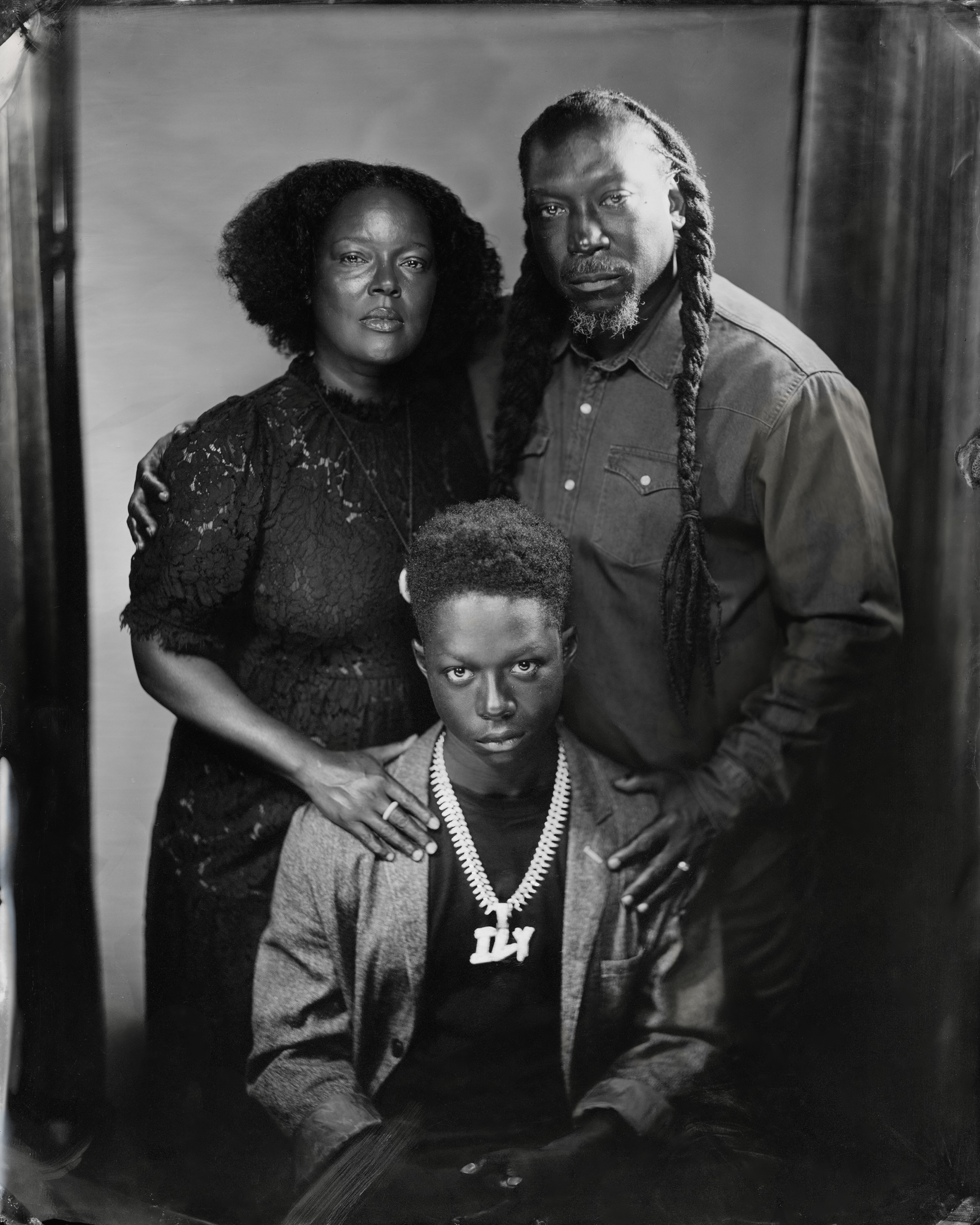
About Bulletin Issue 2
Edited by Monument Lab Senior Curator Yolanda Wisher in partnership with the Emmett Till Interpretive Center’s Daphne R. Chamberlain and Patrick Weems, Bulletin Issue 02 riffs on the theme of “Reverence,” coinciding with the 70th anniversary of Emmett Till’s lynching and Mamie Till-Mobley’s courageous acts of bearing witness in publicly mourning her son that spurred the Civil Rights Movement.

Major support for the Bulletin is provided by the Mellon Foundation.
